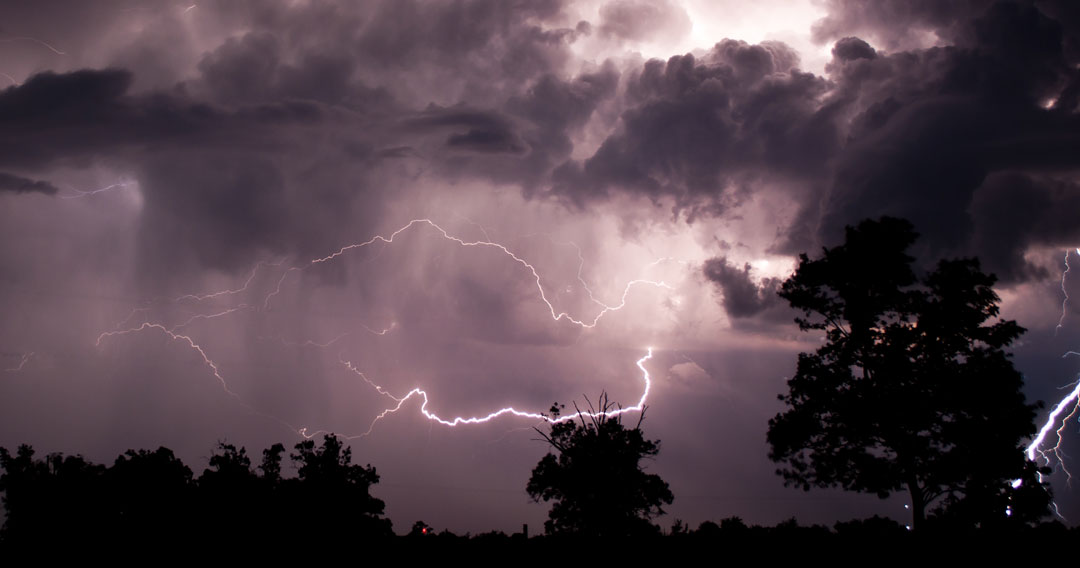Click here for information on earthquakes, fires, and tsunamis.
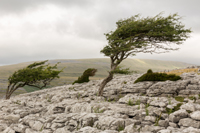 WIND AND SNOW STORMS
WIND AND SNOW STORMS
Virginia City
Virginia City is prone to violent windstorms, sardonically nicknamed “Washoe Zephyrs”. They are generally a summer occurrence, blowing from mid-afternoon until late in the evening, from the west to southwest, with heavy gusts. Mark Twain described them as: “…a soaring dust-drift about the size of the United States set up edgewise…” Roughing It. (1872). The wind-bursts have at times been violent enough to knock over buildings.
Sierra Nevada Mountains
The Sierra Nevada range to the west of Virginia City is renowned for severe winter weather, with over twenty feet of snowpack in places and wind gusts over 150 miles per hour. The best known blizzard is, of course, that which trapped the Donner Party in 1846. However, the winter of 1866-1867 was also exceptionally harsh. It had 44 blizzards which left deep snow at the summit and delayed construction of the transcontinental railroad.
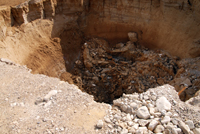 SINKHOLES
SINKHOLES
Sinkholes can be caused by a number of things– collapse of natural underground caverns, subsurface erosion by a hidden spring, or withdrawal of water from the water table, for example.
In Virginia City, the streets of the city are directly above the mines, a hollowed-out maze over half a mile deep of tunnels supported by timbers. Sinkholes, while not common, have occured in the city since the earliest mining days.
On June 19, 1867, a cave-in at the 100-foot level of Chollar-Potosi mine created a sinkhole 200 feet wide at the surface, swallowing a dry-goods store.
In more recent times, major sinkholes have also appeared from time to time. In October 1992 a sinkhole measuring 40 feet in width and 60 feet in depth opened up over the former Bonner Shaft of the Gould & Curry Mine, in the 100 block of South D Street in Virginia City. The cave-in was caused by an underground flowing water leak and rotting timbers. It was filled in with steel and concrete plug and has been trouble free since.
In January 2006 a sinkhole about 30 feet in diameter and 25 feet deep appeared in Highway 342 between Virginia City and Gold Hill, caused by a cave-in of an old mine.
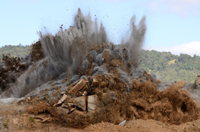 EXPLOSIONS
EXPLOSIONS
High explosives including nitroglycerin and dynamite were developed during the mid-1800s in response to the needs of the construction and mining communities. Methods for safe handling of these substances were in their infancy and at times went horribly wrong.
San Francisco
On April 16, 1866, just as the business community was returning from lunch, an explosion took place in the back of the Wells, Fargo & Co. building, leveling a complete city block. Investigation found that a leaking box of nitroglycerin being shipped via express had exploded in transit.
Virginia City
On June 30, 1873, a violent explosion destroyed the Roots Building and a Bank of California branch in Virginia City. Buildings in all directions were shattered, and an iron door was hurled 100 feet from the explosion. Twelve people were killed and dozens more injured.
Investigation determined that the cause was the detonation of some six cans of nitroglycerin, one hundred fifty pounds of ‘giant powder’ (dynamite) and two hundred pounds of black rock blasting powder. These items were being stored in the apartment of Jacob L. Van Bokkelen, the local sales agent for the dynamite; his pet monkey was blamed for the accident.
No trace was ever found of the monkey.
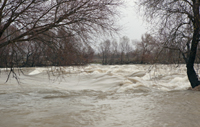 FLOODS
FLOODS
Virginia City
Although Nevada is the driest state in the union, Virginia City experienced record rainfalls and flooding during the 1860s.
In the December 1861 to January 1862 time period, a total of nearly nine inches of precipitation was recorded. The Carson River flooded, washing out bridges and turning the entire valley into a vast lake.
During the month of December 1869, over seven and a half inches of precipitation was recorded, nearly the average total for an entire year.
San Francisco and California
In 1862, a statewide flood hit California. There was record rainfall that year, combined with unseasonable snowfall melt. Moreover, log dams that had been erected to contain mining debris from hydraulic mining in the Sierras failed, pouring a wave of sand, mud, and mining detritus down the Sacramento River.
The Sacramento and San Joaquin valleys were flooded to a depth of seven feet in places, and downtown Sacramento was waist-deep in water. The Capital of California was moved from Sacramento to San Francisco because of the high water. In San Francisco, 35 inches of rain fell during December 1861 and January 1862.
Populations were already concentrated next to rivers and streams, magnifying the problem. The Sacramento Daily Union reported that a third of the taxable property in the state of California was lost.
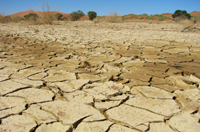 DROUGHT
DROUGHT
Droughts struck California during the years preceding and following the record floods.
The years 1856-57 brought a severe drought, intense summer heat, thunder and lightning, and severe sand storms. It was considered the driest season in twenty years.
In the fall of 1862 an even worse drought struck, and lasted to the winter of 1864-65. Cattle were driven to the Sierras or even as far afield as Oregon for water and feed, but many failed to make it. Starving animals were routinely slaughtered for nothing more than the value of their horns and hides. The weakened herds were preyed upon by mountain lions, bears, and coyotes. When the drought ended, the cattle business in California had all but been destroyed.
 EPIDEMICS
EPIDEMICS
Human Epidemics
The primary epidemics affecting San Francisco and Virginia City in the 1800s were smallpox and cholera; bubonic plague struck at the turn of the century. Because of San Francisco’s relative isolation from the rest of the country, other diseases were epidemic elsewhere but failed to gain a foothold on the West Coast.
Smallpox
Smallpox epidemics occurred throughout the 1800s despite the availability of an effective vaccine. Since neither needles nor injection sites were ever sterilized, infections from vaccinations were rampant and there was popular resistance to the practice.
In the summer of 1868 smallpox arrived in SF, and by August four to five hundred people stood in line every day to receive vaccination.
In 1869 the epidemic spread to Virginia City, and accounted for over half the deaths there that year.
In 1871 the disease returned to the East Coast. It killed over eight hundred people in New York, more than ever before in its history, while in Philadelphia the deaths reached nearly two thousand.
In 1875 and 1876 the disease returned to San Francisco despite the intervening vaccination program, resulting in some 1,646 reported cases with 405 deaths.
Cholera
In 1855, a ship arrived from the Far East bearing refugees from a cholera epidemic there. As sanitation in San Francisco was problematic at that juncture, a cholera epidemic soon broke out. It raged for six weeks until finally brought under control largely due to the efforts of Sisters of Mercy, who were asked to run the San Francisco County Hospital.
Bubonic Plague
On March 6, 1900, Bubonic plague arrived in San Francisco; the epidemic proved difficult to contain and continued sporadically until 1909.
Measles
Measles was a much more severe illness in the 1800s than it is today, and was sometimes fatal due to respiratory and/or cerebral complications. The disease was responsible for the deaths of one-quarter of the mission Indian population in San Francisco in 1806.
Measles also played a significant role in the Civil War. During the first twelve months of the war there were 21,676 reported cases in the Union Army, and 551 deaths.
Yellow Fever, Typhus, Typhoid, Scarlet Fever, Influenza
From 1865 through 1873 a series of recurring epidemics of these diseases struck Philadelphia, New York, Boston, New Orleans, Baltimore, Memphis, & Washington D.C..
The relative isolation of the West Coast until completion of the transcontinental railroad in 1869 helped prevent spread of these diseases to San Francisco and Virginia City.
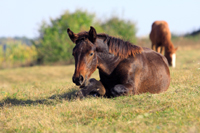 Animal Epidemics
Animal Epidemics
Epizootic (Equine Influenza)
Arguably the most disastrous event to strike the country in the mid 1800s (except for the Civil War) was the epidemic of equine influenza in 1872. The nation was brought to a complete standstill, since every aspect of life depended upon horsepower. Food could not be transported, the mails could not go through, telegraph lines could not be repaired, the military was immobilized, fires could not be fought.
Between early fall 1872 and late spring of 1873 the Epizootic (as it was called) infected virtually every horse, mule and donkey in the United States. All displayed symptoms including discharges from the nose and a heavy cough, and most were totally debilitated for a period of two to three weeks. Mortality rates ranged between 1% and 10%.
The epidemic reached Virginia City on March 11, 1873, and by March 24 was abating. It spread to San Francisco on April 14, 1873, and began to ease up by April 29.
The effect of the epidemic on the national economy was catastrophic. Tens of thousands of businesses failed, a third of all railroads went bankrupt, and unemployment shot up to almost 15 percent. The country was plunged into a six-year depression.
FURTHER READING AND OTHER REFERENCES
Explosions
California Digital Newspaper Collection, Sacramento Daily Union, Volume 45, Number 6940, July 1, 1873, “Terrible Explosion in Virginia City Nevada”, http://cdnc.ucr.edu/cgi-bin/cdnc?a=d&d=SDU18730701.2.2.1#
Floods and Droughts
United States Geological Survey, Major Floods And Droughts In California,
http://geochange.er.usgs.gov/sw/impacts/hydrology/state_fd/cawater1.html
(Posted February 2014)
